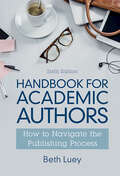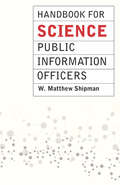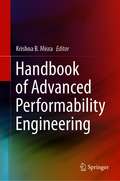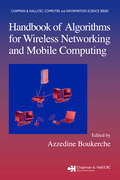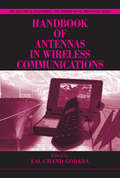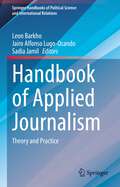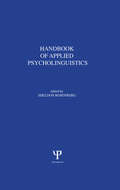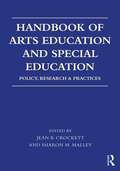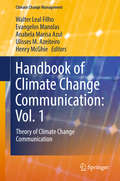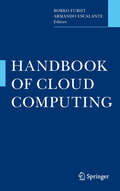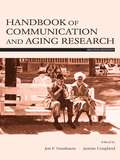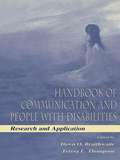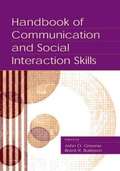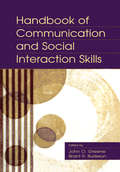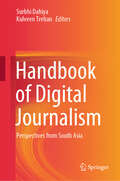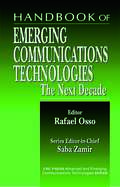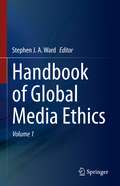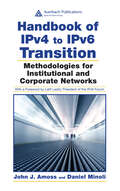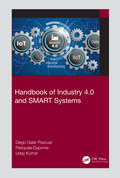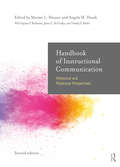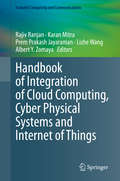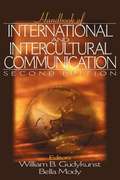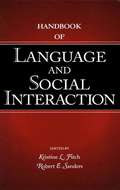- Table View
- List View
Handbook for Academic Authors
by Beth LueyWhether you are a graduate student seeking to publish your first article, a new Ph. D. revising your dissertation for publication, or an experienced author working on a new monograph, textbook, or digital publication, Handbook for Academic Authors provides reliable, concise advice about selecting the best publisher for your work, maintaining an optimal relationship with your publisher, submitting manuscripts to book and journal publishers, working with editors, navigating the production process, and helping to market your book. It also offers information about illustrations, indexes, permissions, and contracts and includes a chapter on revising dissertations and one on the financial aspects of publishing. The book covers not only scholarly monographs but also textbooks, anthologies, multiauthor books, and trade books. The fifth edition has been revised and updated to align with new technological and financial realities, taking into account the impact of digital technology and the changes it has made in authorship and publishing.
Handbook for Academic Authors: How to Navigate the Publishing Process
by Beth LueyWhether you are a faculty member, a librarian, an independent scholar, the junior member of a research team, or a writer outside academia, Handbook for Academic Authors will help you select the right publisher, submit a winning proposal, negotiate a favorable contract, and work with your editor to ensure your research reaches the largest possible audience. The book provides advice on writing for different audiences and managing the mechanics of authorship, including manuscript preparation, acquiring illustrations, proofreading, and indexing. To address the major changes in scholarly publishing over the last decade, the sixth edition has been revised and updated to include discussions about open access and digital publishing, the use of social media as a marketing tool, changes within academia, and concerns of new entrants into academia. Written in a personalized, accessible style, Handbook for Academic Authors offers sound advice and encouragement to a wide range of aspiring academic authors.
Handbook for Science Public Information Officers
by W. Matthew ShipmanWhether sharing a spectacular shot from a deep-space probe, announcing a development in genetic engineering, or crafting an easy-to-reference list of cancer risk factors, science public information officers, or PIOs, serve as scientific liaisons, connecting academic, nonprofit, government, and other research organizations with the public. And as traditional media outlets cut back on their science coverage, PIOs are becoming a vital source for science news. W. Matthew Shipman’s Handbook for Science Public Information Officers covers all aspects of communication strategy and tactics for members of this growing specialty. It includes how to pitch a story, how to train researchers to navigate interviews, how to use social media effectively, and how to respond to a crisis. The handbook offers a wealth of practical advice while teaching science PIOs how to think critically about what they do and how they do it, so that they will be prepared to take advantage of any situation, rather than being overwhelmed by it. For all science communicators—whether they’re starting their careers, crossing over from journalism or the research community, or professional communicators looking to hone their PIO skills—Shipman’s Handbook for Science Public Information Officers will become their go-to reference.
Handbook of Advanced Performability Engineering
by Krishna B. MisraThis book considers all aspects of performability engineering, providing a holistic view of the activities associated with a product throughout its entire life cycle of the product, as well as the cost of minimizing the environmental impact at each stage, while maximizing the performance. Building on the editor's previous Handbook of Performability Engineering, it explains how performability engineering provides us with a framework to consider both dependability and sustainability in the optimal design of products, systems and services, and explores the role of performability in energy and waste minimization, raw material selection, increased production volume, and many other areas of engineering and production. The book discusses a range of new ideas, concepts, disciplines, and applications in performability, including smart manufacturing and Industry 4.0; cyber-physical systems and artificial intelligence; digital transformation of railways; and asset management. Given its broad scope, it will appeal to researchers, academics, industrial practitioners and postgraduate students involved in manufacturing, engineering, and system and product development.
Handbook of Algorithms for Wireless Networking and Mobile Computing (Chapman & Hall/CRC Computer and Information Science Series)
by Azzedine BoukercheThe Handbook of Algorithms for Wireless Networking and Mobile Computing focuses on several aspects of mobile computing, particularly algorithmic methods and distributed computing with mobile communications capability. It provides the topics that are crucial for building the foundation for the design and construction of future generations of mobile and wireless networks, including cellular, wireless ad hoc, sensor, and ubiquitous networks. Following an analysis of fundamental algorithms and protocols, the book offers a basic overview of wireless technologies and networks. Other topics include issues related to mobility, aspects of QoS provisioning in wireless networks, future applications, and much more.
Handbook of Antennas in Wireless Communications (Electrical Engineering & Applied Signal Processing Series #4)
by Lal Chand GodaraThe move toward worldwide wireless communications continues at a remarkable pace, and the antenna element of the technology is crucial to its success. With contributions from more than 30 international experts, the Handbook of Antennas in Wireless Communications brings together all of the latest research and results to provide engineering professionals and students with a one-stop reference on the theory, technologies, and applications for indoor, hand-held, mobile, and satellite systems.Beginning with an introduction to wireless communications systems, it offers an in-depth treatment of propagation prediction and fading channels. It then explores antenna technology with discussion of antenna design methods and the various antennas in current use or development for base stations, hand held devices, satellite communications, and shaping beams. The discussions then move to smart antennas and phased array technology, including details on array theory and beamforming techniques. Space diversity, direction-of-arrival estimation, source tracking, and blind source separation methods are addressed, as are the implementation of smart antennas and the results of field trials of systems using smart antennas implemented. Finally, the hot media topic of the safety of mobile phones receives due attention, including details of how the human body interacts with the electromagnetic fields of these devices.Its logical development and extensive range of diagrams, figures, and photographs make this handbook easy to follow and provide a clear understanding of design techniques and the performance of finished products. Its unique, comprehensive coverage written by top experts in their fields promises to make the Handbook of Antennas in Wireless Communications the standard reference for the field.
Handbook of Applied Journalism: Theory and Practice (Springer Handbooks of Political Science and International Relations)
by Leon Barkho Sadia Jamil Jairo Alfonso Lugo-OcandoThis authoritative handbook looks at the entire news cycle and provides a bridge between the theoretical and academic study of journalism and its actual contemporary practice. The book's main merit is that it brings theory and practice together, with contributors discussing these issues from different perspectives in a way that scholars, students, and practitioners can find useful in the study of journalism. The handbook is also unique as it undertakes an international scope across regions and cultures, both from the West and the Global South, while providing an overview which balances the (over-) emphasis on content in most academic approaches to journalism.The book is divided into four major parts: (1) Conceptual foundations, (2) Interlink between journalism as scholarship and journalism as practice, (3) Regions and cultures, and (4) The practitioner world. The first two sections lay down the foundation for section (3) which provides an overview of journalism practice in different regions and cultures. Section (4) includes contributions by practitioners in which they attempt to respond to some of the issues raised in preceding sections.This handbook will appeal to academics, practitioners, and professionals alike, who are interested in a better understanding of the academic study of journalism and its actual contemporary practice.
Handbook of Applied Psycholinguistics: Major Thrusts of Research and Theory
by Sheldon RosenbergFirst published in 1982. The chapters of this handbook contain critical integrative reviews of research and theory in the major areas of the field of applied psycholinguistics, the field in which applied problems of language and communicative functioning and development are approached from the standpoint of basic research and theory in psycholinguistics and related areas of cognitive psychology. The book was designed to meet the needs of researchers, practitioners and graduate students from such disciplines as education (including special education), language learning, linguistics, neurology, psychiatry, psychology, and speech and hearing for such reviews, although the state of research in an area and a desire to stress research and theory in substantive areas resulted in a decision not to include chapters on the measurement of linguistic maturity, language intervention, the language of the learning disabled child, language and environmental deprivation, language and mania, language and senile dementia, and the design of written and oral information and computer command language.
Handbook of Arts Education and Special Education: Policy, Research, and Practices
by Jean B. Crockett Sharon M. MalleyThe Handbook of Arts Education and Special Education brings together, for the first time in a single reference volume, policy, research, and practices in special education and arts education synthesized to inform stakeholders across a broad spectrum of education. This handbook encompasses arts education for students with disabilities, from pre-K through transition to postsecondary education and careers as well as community arts education, with particular attention to conceptual foundations; research-based practices; professional standards; students’ cognitive, artistic, and social growth; career education; and future directions for research and practice in special education and arts education.
Handbook of Climate Change Communication: Vol. 1
by Walter Leal Filho Ulisses M. Azeiteiro Anabela Marisa Azul Evangelos Manolas Henry McGhieThis comprehensive handbook provides a unique overview of the theory, methodologies and best practices in climate change communication from around the world. It fosters the exchange of information, ideas and experience gained in the execution of successful projects and initiatives, and discusses novel methodological approaches aimed at promoting a better understanding of climate change adaptation. Addressing a gap in the literature on climate change communication and pursuing an integrated approach, the handbook documents and disseminates the wealth of experience currently available in this field. Volume 1 of the handbook provides a unique description of the theoretical basis and of some of the key facts and phenomena which help in achieving a better understanding of the basis of climate change communication, providing an essential basis for successful initiatives in this complex field.
Handbook of Cloud Computing
by Borko Furht Armando EscalanteCloud computing has become a significant technology trend. Experts believe cloud computing is currently reshaping information technology and the IT marketplace. The advantages of using cloud computing include cost savings, speed to market, access to greater computing resources, high availability, and scalability. Handbook of Cloud Computing includes contributions from world experts in the field of cloud computing from academia, research laboratories and private industry. This book presents the systems, tools, and services of the leading providers of cloud computing; including Google, Yahoo, Amazon, IBM, and Microsoft. The basic concepts of cloud computing and cloud computing applications are also introduced. Current and future technologies applied in cloud computing are also discussed. Case studies, examples, and exercises are provided throughout. Handbook of Cloud Computing is intended for advanced-level students and researchers in computer science and electrical engineering as a reference book. This handbook is also beneficial to computer and system infrastructure designers, developers, business managers, entrepreneurs and investors within the cloud computing related industry.
Handbook of Communication and Aging Research
by Jon F. Nussbaum Justine CouplandThis second edition of the Handbook of Communication and Aging Research captures the ever-changing and expanding domain of aging research. Since it was first recognized that there is more to social aging than demography, gerontology has needed a communication perspective. Like the first edition, this handbook sets out to demonstrate that aging is not only an individual process but an interactive one. The study of communication can lead to an understanding of what it means to grow old. We may age physiologically and chronologically, but our social aging--how we behave as social actors toward others, and even how we align ourselves with or come to understand the signs of difference or change as we age--are phenomena achieved primarily through communication experiences.Synthesizing the vast amount of research that has been published on communication and aging in numerous international outlets over the last three decades, the book's contributors include scholars from North America and the United Kingdom who are active researchers in the perspectives covered in their particular chapter. Many of the chapters work to deny earlier images of aging as involving normative decrement to provide a picture of aging as a process of development involving positive choices and providing new opportunities. A recuring theme in many chapters is that of the heterogeneity of the group of people who are variously categorized as older, aged, elderly, or over 65. The contributors review the literature analytically, in a way that reveals not only current theoretical and methodological approaches to communication and aging research but also sets the future agenda.This handbook will be of great interest to scholars and researchers in gerontology, developmental psychology, and communication, and, in this updated edition, will continue to play a key role in the study of communication and aging.
Handbook of Communication and People With Disabilities: Research and Application (Routledge Communication Series)
by Dawn O. Braithwaite Teresa L. ThompsonThis Handbook represents the first comprehensive collection of research on communication and people with disabilities. The editors have brought together original contributions focusing on the identity, social, and relationship adjustments faced by people with disabilities and those with whom they relate. Essays report on topics across the communication spectrum--interpersonal and relationship issues, people with disabilities in organizational settings, disability and culture, media and technologies, communication issues as they impact specific types of disabilities--and establish a future agenda for communication and disability research. Each chapter provides a state-of-the-art literature review, practical applications of the material, and keywords and discussion questions to facilitate classroom use. In providing an outlet for current research on communication and disability issues, this unique collection contributes to the lives of people with and without disabilities, helping them to improve their own communication and relationships. Intended for readers in communication, psychology, sociology, rehabilitation, social work, special education, gerontology, and related disciplines, this handbook is certain to augment further theory and research, as well as offer insights for both personal and professional relationships.
Handbook of Communication and Social Interaction Skills
by John O. Greene Brant Raney BurlesonProviding a survey of the theory and research on social interaction skills, this volume contains 24 papers on theoretical and methodological concerns in research, fundamental interaction skills, function-focused skills, the management of diverse personal relationships, and the sills required by public and professional life. Specific chapters discuss models of skill acquisition, methods of assessment, persuasion, friendship, marriage, management, leadership, and teaching. Empirically supported strategies for developing and enhancing these skills are emphasized. Annotation (c)2003 Book News, Inc., Portland, OR (booknews.com)
Handbook of Communication and Social Interaction Skills (Routledge Communication Series)
by JOHN O. GREENE; BRANT R. BURLESONProviding a thorough review and synthesis of work on communication skills and skill enhancement, this Handbook serves as a comprehensive and contemporary survey of theory and research on social interaction skills. Editors John O. Greene and Brant R. Burleson have brought together preeminent researchers and writers to contribute to this volume, establishing a foundation on which future study and research will build. The handbook chapters are organized into five major units: general theoretical and methodological issues (models of skill acquisition, methods of skill assessment); fundamental interaction skills (both transfunctional and transcontextual); function-focused skills (informing, persuading, supporting); skills used in management of diverse personal relationships (friendships, romances, marriages); and skills used in varied venues of public and professional life (managing leading, teaching). Distinctive features of this handbook include:* broad, comprehensive treatment of work on social interaction skills and skill acquisition;* up-to-date reviews of research in each area; and* emphasis on empirically supported strategies for developing and enhancing specific skills.Researchers in communication studies, psychology, family studies, business management, and related areas will find this volume a comprehensive, authoritative source on communications skills and their enhancement, and it will be essential reading for scholars and students across the spectrum of disciplines studying social interaction.
Handbook of Digital Journalism: Perspectives from South Asia
by Surbhi Dahiya Kulveen TrehanThis book presents perspectives from South Asian countries, such as India, Nepal, Sri Lanka, Bangladesh, and Bhutan. It brings in-depth perspectives on content, communication, and community between communication theory and the digital news ecosystem rooted in a South Asian culture-centric approach. The book thoroughly investigates changes in the regulatory framework, regulations, policies, and code of conduct. It engages debates on digital journalism practices modeled around mobile journalism, immersive storytelling, and gamification in the context of local and hyper-local communities in South Asia. The book provides a cohesive compilation offering readers an up-to-date and comprehensive understanding of digital developments in journalism. It also helps journalists and practitioners working in news media to discover new types of information flows in a rapidly changing news media landscape.Digital Journalism: Perspectives from South Asia is a descriptive, exploratory book on digital journalism practices and policies followed in India, Nepal, Sri Lanka, Bangladesh, and Bhutan. It brings in-depth perspectives on content, communication, and community between communication theory and the digital news ecosystem rooted in a South Asia. What makes this book interesting to read is the integration of forms with manifestations on ground intersecting identities and ideologies. The book thoroughly investigates changes in the regulatory framework, regulations, policies, and code of conduct. Various chapters in the book pursue significant and exciting topics on the changing spaces of news production and consumption, the inter relationship between old and new media, everyday digital news usage and engagement, social media for news, revenue models for digital journalism among others. The highlight of this book is engaging debates on digital journalism practices modeled around mobile journalism, immersive storytelling, gamification, in the context of local and hyper local communities in South Asia. Since Digital Journalism draws extensively from algorithms, matrices and analytics, this book has exclusive chapters on data journalism, data visualization and big data.. The book provides a cohesive compilation offering readers an up-to-date and comprehensive understanding of digital developments in journalism. It also helps journalists and practitioners working in news media to discover new types of information flows in a rapidly changing news media landscape. It also articulates indegenous concerns of journalists, their security, risks and challenges as they explore the new contours of journalistic practices.
Handbook of Emerging Communications Technologies: The Next Decade (Advanced & Emerging Communications Technologies)
by Rafael OssoCommunication technologies change the way we live our lives-the ways we communicate and share information, the news, and our entertainment. The new millennium promises to bring some of the most volatile activity in the history of communications, as we continue to be bombarded by new standards and technologies. The near frenzy of corporate mergers and acquisitions accelerates technological development and can provide hints of what is to come. With the rapid appearance of new protocols, standards, and tools, it becomes increasingly difficult -and increasingly important-for communications professionals to remain up-to-date on new and emerging technologies.The Handbook of Emerging Communications Technologies: The Next Decade fills this gap. Until now, information on many of its topics, such as Multiprotocol over ATM, IP Multicasting, and RSVP, existed only as fragmented articles on the Internet or as complex feature specifications. In this landmark volume, 18 leading authorities each tackle one of the cutting edge technologies destined to shape the future. Each chapterDescribes a technology and any standards on which it is based Discusses its impact on the communications field Forecasts its future directionDeveloped primarily for telecommunications specialists network managers, developers, and analysts, the Handbook of Emerging Communications Technologies: The Next Decade, offers the opportunity to acquire a deeper understanding of future technologies necessary to remaining current, and serves as a valuable reference guide for corporate executives, planners, and information managers-anyone seeking general knowledge about where the communications industry is heading.
Handbook of Global Media Ethics
by Stephen J. A. WardThis handbook is one of the first comprehensive research and teaching tools for the developing area of global media ethics. The advent of new media that is global in reach and impact has created the need for a journalism ethics that is global in principles and aims. For many scholars, teachers and journalists, the existing journalism ethics, e.g. existing codes of ethics, is too parochial and national. It fails to provide adequate normative guidance for a media that is digital, global and practiced by professional and citizen. A global media ethics is being constructed to define what responsible public journalism means for a new global media era. Currently, scholars write texts and codes for global media, teach global media ethics, analyse how global issues should be covered, and gather together at conferences, round tables and meetings. However, the field lacks an authoritative handbook that presents the views of leading thinkers on the most important issues for global media ethics. This handbook is a milestone in the field, and a major contribution to media ethics.
Handbook of IPv4 to IPv6 Transition: Methodologies for Institutional and Corporate Networks
by Daniel Minoli John J. AmossThe implementation of IPv6 is essential to the continued growth of the Internet and the development of new applications. The Handbook of IPv4 to IPv6 Transition Methodologies provides a wealth of best practices and procedures that will help corporations plan and implement a smooth transition to IPv6.A blueprint for successful transition, the Handbo
Handbook of Industry 4.0 and SMART Systems
by Uday Kumar Diego Galar Pascual Pasquale DaponteIndustry 4.0 refers to fourth generation of industrial activity characterized by smart systems and internet-based solutions. This book describes the fourth revolution based on instrumented, interconnected and intelligent assets. The different book chapters provide a perspective on technologies and methodologies developed and deployed leading to this concept. With an aim to increase performance, productivity and flexibility, major application area of maintenance through smart system has been discussed in detail. Applicability of 4.0 in transportation, energy and infrastructure is explored, with effects on technology, organisation and operations from a systems perspective.
Handbook of Instructional Communication: Rhetorical and Relational Perspectives
by Angela Hosek Marian L. HouserThe Handbook of Instructional Communication offers a comprehensive collection of theory and research focusing on the role and effects of communication in instructional environments. Now in its Second Edition, the handbook covers an up-to-date array of topics that includes social identity, technology, and civility and dissent. This volume demonstrates how to understand, plan, and conduct instructional communication research as well as consult with scholars across the communication discipline. Designed to address the challenges facing educators in traditional and nontraditional settings, this edition features a wealth of in-text resources, including directions for future research, suggested readings, and surveys for instructional assessment.
Handbook of Integration of Cloud Computing, Cyber Physical Systems and Internet of Things (Scalable Computing and Communications)
by Lizhe Wang Albert Y. Zomaya Rajiv Ranjan Karan Mitra Prem Prakash JayaramanThis handbook covers recent advances in the integration of three areas, namely, cloud computing, cyber-physical systems, and the Internet of things which is expected to have a tremendous impact on our daily lives. It contains a total of thirteen peer-reviewed and edited chapters. This book covers topics such as context-aware cyber-physical systems, sustainable cloud computing, fog computing, and cloud monitoring; both the theoretical and practical aspects belonging to these topics are discussed. All the chapters also discuss open research challenges in the areas mentioned above. Finally, the handbook presents three use cases regarding healthcare, smart buildings and disaster management to assist the audience in understanding how to develop next-generation IoT- and cloud-enabled cyber-physical systems. This timely handbook is edited for students, researchers, as well as professionals who are interested in the rapidly growing fields of cloud computing, cyber-physical systems, and the Internet of things.
Handbook of International and Intercultural Communication
by William B. Gudykunst Bella ModyGudykunst (speech communication, Asian American studies, Cal. State U., Fullerton) and Mody (telecommunications, Michigan State U.) present this reference for scholars, new researchers and graduate students in international or intercultural communication. Twenty-nine chapters were contributed by 42 accomplished scholars. Where the first edition focused primarily on intercultural communication, this new edition gives equal coverage to four areas: cross-cultural, intercultural, international, and developmental communication. Annotation c. Book News, Inc., Portland, OR (booknews.com)
Handbook of Language and Literacy, Second Edition
by Elaine R. Silliman C. Addison Stone Barbara J. Ehren Geraldine P. WallachAn acclaimed reference that fills a significant gap in the literature, this volume examines the linkages between spoken and written language development, both typical and atypical. Leading authorities address the impact of specific language-related processes on K-12 literacy learning, with attention to cognitive, neurobiological, sociocultural, and instructional issues. Approaches to achieving optimal learning outcomes with diverse students are reviewed. The volume presents research-based practices for assessing student needs and providing effective instruction in all aspects of literacy: word recognition, reading comprehension, writing, and spelling. New to This Edition *Chapters on digital literacy, disciplinary literacy, and integrative research designs. *Chapters on bilingualism, response to intervention, and English language learners. *Incorporates nearly a decade's worth of empirical and theoretical advances. *Numerous prior edition chapters have been completely rewritten.
Handbook of Language and Social Interaction (Routledge Communication Series)
by Kristine L. Fitch Robert E. SandersThis Handbook stands as the premier scholarly resource for Language and Social Interaction (LSI) subject matter and research, giving visibility and definition to this area of study and establishing a benchmark for the current state of scholarship. The Handbook identifies the five main subdisciplinary areas that make up LSI--language pragmatics, conversation analysis, language and social psychology, discourse analysis, and the ethnography of communication. One section of the volume is devoted to each area, providing a forum for a variety of authoritative voices to provide their respective views on the central concerns, research programs, and main findings of each area, and to articulate the present or emergent issues and directions. A sixth section addresses LSI in the context of broadcast media and the Internet. This volume's distinguished authors and original content contribute significantly to the advancement of LSI scholarship, circumscribing and clarifying the interrelationships among the questions, findings, and methods across LSI's subdisciplinary areas. Readers will come away richer in their understanding of the variety and depth of ways the intricacies of language and social interaction are revealed. As an essential scholarly resource, this Handbook is required reading for scholars, researchers, and graduate students in language and social interaction, and it is destined to have a broad influence on future LSI study and research.

